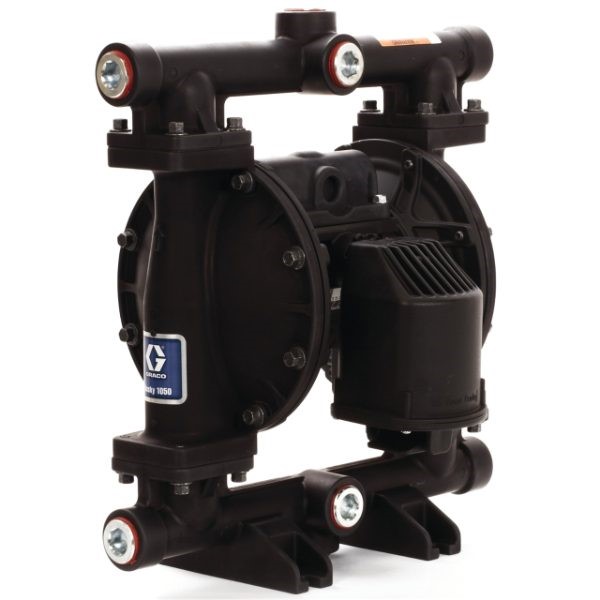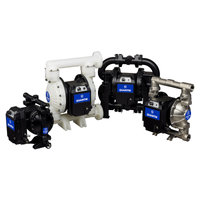Peristaltic pumps vs diaphragm pumps - advantages and disadvantages
Understand the advantages and disadvantages of peristaltic pumps vs electric diaphragm pumps.
What is a peristaltic pump?
Peristaltic pumps, also known as roller pumps, are a type of positive displacement pump designed to cater for a wide range of fluid transfer applications. They are widely used and trusted in a variety of industries, such as food and beverage manufacturing, chemical metering/dispensing, water treatment, pulp and paper, and the concrete industry. However, peristaltic pumps do still suffer from a range of problems that electric double diaphragm pumps can solve.
Advantages of peristaltic pumps
- Simplified design
Peristaltic pumps have a minimal number of moving parts compared to other pump technologies. This design helps to diminish the likelihood of mechanical failures and lessen the need for routine service. - Easy to operate
Most peristaltic pumps are generally easy to set up and operate. This eliminates the need for any specialised training that many other pump technologies require. - Pump efficiency
Peristaltic pumps have the ability to run dry and self-prime. These features are important in reducing leaks and increasing pump efficiency.
Disadvantages of peristaltic pumps
- Limited hose life
The flexible hose used in roller pumps tends to degrade with time, particularly when used with abrasives. Unless the unit is equipped with an expensive leak protection feature, rupture of the hose can cause leaks, leading to hazardous situations and contamination of the pumped fluid. Because of this, hoses need to be replaced frequently. - A larger footprint
Peristaltic pumps take up a lot of space, particularly when it comes to higher flow rates. Compared to electric diaphragm pumps, peristaltic pumps require a much larger footprint to achieve the same flow rates. - Pulsed flow
Roller pumps do not have a smooth and consistent flow. When the rollers are released, liquid back suction occurs, causing a sudden reduction in the discharge of the liquid. Getting rid of these pulses is expensive: It requires the installation of a dual pump head style unit to achieve natural pulse offset or use of pulsation dampeners.
Graco electric diaphragm pumps
When compared to a traditional peristaltic pump, Graco’s QUANTM pump provides the same flow rate but at a much lower price, which can lead to significant savings. Graco’s QUANTM pump is an electric double diaphragm pump (EODD) that addresses many of these common disadvantages of peristaltic pumps.
- Reduced maintenance costs
Diaphragms generally cost less than large hoses. In addition, diaphragms typically outlast hoses when running at similar speeds and for similar fluid applications, with a product life span reaching up to five times that of peristaltic pump hoses. Less maintenance, at a lower cost. - A small footprint
The QUANTM EODD is extremely compact, so it takes up minimal space on the factory floor. Roller pumps require a much larger footprint to achieve the same flow rates. - Stalls under pressure
One of the key advantages of the QUANTM pump is that it is the only electric double diaphragm pump on the market that stalls under pressure without external sensors. This eliminates the risk of damaging the pump or pipeline when it is blocked or a valve is closed. - Low pulsation
QUANTM pumps are great for applications that require lower pulsation and a smoother flow. Pulsation still exists but because of the cycle rate of the double diaphragm pumps in play, the pulses are less perceivable or impactful on the process.
Common peristaltic pump uses and applications
While peristaltic pumps are commonly used in various industries due to their ability to handle a wide range of fluids, they may not always be the best fit for every application. Here is a look at how peristaltic pumps are used in specific industries and QUANTM’s potential advantages:
- Food and beverage manufacturing
Peristaltic pumps are used in food and beverage manufacturing because of their ability to ensure sanitary conditions. However, QUANTM pumps offer a significant advantage with their seal-less design, reducing contamination risks. Their easy-to-clean design aligns well with the stringent hygiene standards of the industry. - Chemical metering and dispensing
While peristaltic pumps are capable of precise dosing, their hoses wear out and need regular replacement when used with harsh chemicals. QUANTM pumps are built to resist corrosive substances with minimal maintenance. The ability to run dry makes them a more durable and reliable option for chemical metering and dispensing applications. - Pulp and paper
The pulp and paper industry requires transfer of viscous fluids and slurries with varying solid contents. Many peristaltic pumps have issues with such fluids due to the potential for hose degradation and clogging. QUANTM pumps are a more efficient solution with their ability to pump highly viscous fluids without any concerns about hose failure. This reduces downtime and increases productivity in pulp and paper manufacturing processes.
In each of these applications, QUANTM electric diaphragm pumps have unique advantages over peristaltic pumps. By offering enhanced durability, lower maintenance costs, and the ability to handle a wider range of substances, QUANTM can save money and increase output.
Peristaltic pumps vs diaphragm pumps
These are the QUANTM electric double diaphragm (EODD) pump benefits at a glance:
| Peristaltic (roller) pumps | Graco QUANTM EODD pumps |
| High operating costs for large flow rates | Low operating costs, even for large flow rates |
| Limited hose life | Diaphragms last up to 5x longer than hose |
| High maintenance costs for hose repair | Easy to repair at low cost |
| A large footprint | A smaller footprint |
| Pulsation | Low pulsation, smooth flow |
| Unable to stall under pressure | Stalls under pressure |
ROI calculator
Interested in going electric?
Answering three easy questions, calculate how much you could save by converting your facility to Graco electric double-diapragm pumps.
1) What industry are you in?
Based on your industry, we can set some default system requirements, like pump size, flow rate, and fluid pressure. Have you got a highly customised setup? Try our Advanced configurator.
2) How many pumps do you have?
We will estimate your savings based on the number and energy consumption of the pumps you already own.
3) What are your energy costs?
We will estimate your energy savings based on the average energy prices in your area.
Annual operational savings:
Check out our Advanced ROI calculator to learn how we calculated your savings.
Start again

Related articles
The eleven benefits of an electric diaphragm pump
Understand the working principle of a diaphragm pump, the different types of diaphragm pumps, and the common uses and applications.
Electric oil pumps lead the way to improve energy efficiency and sustainability goals
Electric pumps lead the way to energy efficiency and sustainability goals
Electric diaphragm (EODD) pumps vs other technologies: pros and cons
There are many different types of industrial pumps, including diaphragm pumps, gear pumps, peristaltic pumps, and more. See an overview of each.




